View basket (0 items $0.00)
Error message
- Notice: unserialize(): Error at offset 5 of 154 bytes in variable_initialize() (line 1202 of /home/dh_6hcdc2/yogau.online/docroot/includes/bootstrap.inc).
- The file could not be created.
- The file could not be created.
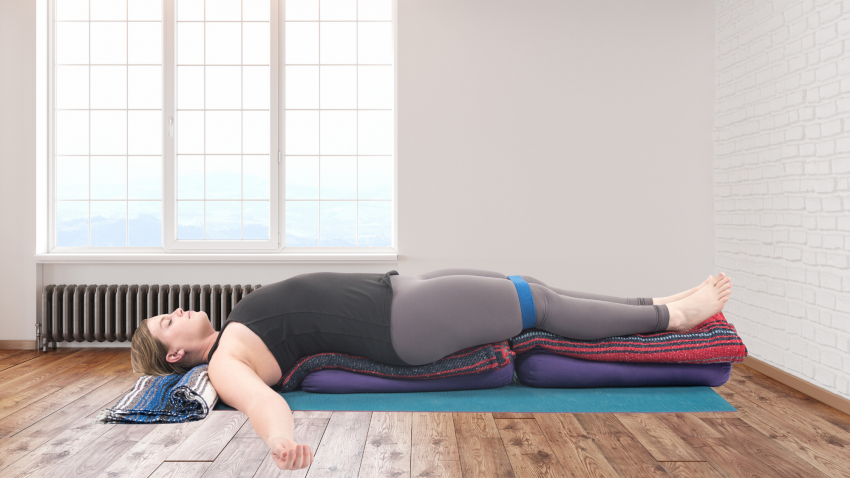
Fatigue Got You Down? Try This Restorative Yoga Sequence
Too tired. For many, it’s the default response to every request—even the fun ones. Some of the walking weary are simply too overworked or overstressed to get adequate rest. While others may feel drained by a physical ailment, a psychological condition, or the side effects of medication. Whatever the cause, all can benefit from the respite that a Restorative yoga practice provides.
Why not a vigorous practice? When someone is deeply fatigued, a dynamic practice, like a double espresso, can be depleting, despite its initial invigorating jolt. Restorative yoga, on the other hand, soothes the senses, so they stop urging the mind and nervous system to react and instead turn their attention inward—on the breath or embedded tension, for example. These asanas also lower anxiety levels and calm the fight-or-flight response—the stress-induced outpouring of adrenalin and other hormones that taxes the systems of the body.
Furthermore, deep, long-standing fatigue can turn the simple, unconscious effort of standing upright into an exhausting task. When the shoulders stoop, and the spine sags, the chest and diaphragm get compressed, the breath becomes shallow, and the abdomen tightens. Under these circumstances, who has the strength or energy to hold their body with integrity in a yoga asana? That’s why blankets, bolsters, blocks, and belts are essential props in a Restorative practice. With their help, passive supported backbends allow the chest to expand without physical effort and open the body and mind to the stimulating effects of the pose without draining already-low energy reserves.
Yoga Poses to Relieve Fatigue
For this sequence: The Four Bs (bolsters, blankets, blocks, and belts) help open the body to deep relaxation.
The first asana of this sequence, Salamba Purvottanasana (Supported Upward Plank Pose), broadens and lifts the chest and frontal diaphragm away from the lower body. This posture encourages the inhalation to expand outward and upward toward the top chest, bringing lightness, while the abdomen can flow downward and soften on the exhalation.
Similarly, supported forward bends quiet the mind and body and provide a reprieve from overstimulation by turning the attention of the brain and senses of perception inward. At the same time, because the bolsters and blankets support the organs in the frontal body, the back of the body and kidneys relax and spread, further relieving tension.
Finally, inversions provide support for all of the body’s systems, especially the immune and endocrine systems, and thus help address various kinds of hormonal issues—like adrenal fatigue. Inversions give the heart a rest from its effort to pump blood to the brain and let gravity help refresh the legs and lower body from heaviness and vascular stagnation.
All of these asanas are meant to be held for up to 10 minutes each. However, if you experience any pain or strain, you may need to rearrange your props or gradually build up your endurance for each pose.
Salamba Purvottanasana (Over Two Chairs or a Bed)
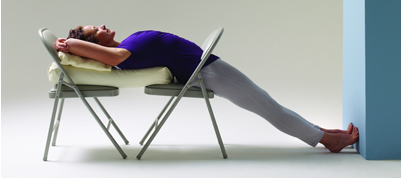
-
Place a bolster across the seats of two chairs positioned seat to seat, a few feet from the wall, with the majority of the bolster on the chair farthest away from the wall. Fold a blanket and place it at the back end of the bolster.
-
Sit at the edge of the chair with the bolster a few inches away from your buttocks.
-
Keep your knees bent, feet on the floor and lie back over the bolster. Place the blanket under the back of your neck and head so that your head isn’t tilting backward.
-
Extend your legs and place your toes on the wall, and heels on the floor. Slowly push away from the wall to straighten your legs.
-
Roll your shoulders underneath you so that your chest lifts and spreads. Let your arms release to your sides.
-
After a few minutes, you may wish to change your arm position. You can rest your hands on your front ribs or hold your elbows and take your arms overhead.
-
Breathe here for up to 10 minutes. To come out, bend your knees and use your hands to help you gently sit up.
Supta Baddha Konasana (Reclining Bound Angle Pose)

-
Place a bolster lengthwise a few inches behind you and sit in front of it with your knees bent. Fold a blanket on the other end of the bolster for your head and neck.
-
Bend your knees to the sides and join the soles of your feet together. Tie a large loop through a belt and slip it over your head and around your lower back. Pull the loop in front of you over your toes and underneath your feet so that the sides of your belt are on the inside edges of your legs. Now bring your feet closer to your pelvis and tighten the belt so that it is holding your legs close to your torso. Don’t make the belt so tight that you feel a pull on your knees.
-
Lie back onto the bolster and place your head on the blanket so that it doesn’t tilt back. With your hands, slide your sacrum and buttocks toward your feet so that your lower back feels long. If you feel any compression in the lower back, you may need to slide a bit more off the bolster toward your feet.
-
Pull your shoulder blades away from your neck and roll the outer edges of your shoulders down so that the chest spreads from the center to the sides. Let your arms release to your sides on the floor, spreading away from your chest, rotated outward, palms facing up.
-
If you feel any strain in your knees or inner thighs, place a support underneath the outer edge of each leg.
-
Close your eyes and rest for up to 10 minutes. Allow the abdomen to recede away from your chest on the exhalations as your chest expands outward and upward on the inhalations.
Viparita Dandasana (Inverted Staff Pose) and Setu Bandha Sarvangasana (Bridge Pose) Over Bolsters

-
Position two bolsters end to end and place two blankets, folded lengthwise, on top to cover each bolster. Sit on the front bolster with your back to the other bolster.
-
Tie one belt firmly around your thighs and one around your ankles to hold your legs together. Keep your knees bent and lie down on your back on the bolster. Pushing off with your feet, slide back until your head rests on the floor, but keep your shoulders on the bolster.
-
Straighten your legs and extend your arms straight overhead until the backs of your hands rest on the floor. Lengthen the side body toward your arms, and your sacrum toward your heels. If you feel any compression in the lower back, actively lengthen the backs of your legs toward your heels, turn the thighs in, and lift your tailbone (or bend your knees).
-
Rest there for 3 to 5 minutes.
-
Now bend your knees and slide off the bolster until your shoulders and head both rest on the floor.
-
Straighten your legs. Extend your buttocks and the backs of your thighs toward your heels. Rest your arms alongside the bolster, palms facing upward. Tuck your shoulders underneath and rotate your upper arms out to broaden your chest. Keep your chest broad as you relax your abdomen and diaphragm.
-
After 5 to 10 minutes, bend your knees and slide off the bolster until your pelvis reaches the floor.
-
Rest on your back with your thighs on the bolster for 30 seconds before turning to your side, untying your legs, and sitting up.
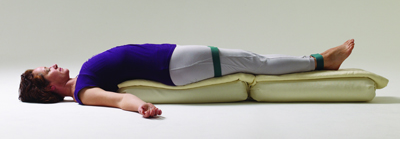
Adho Mukha Svastikasana (Downward-Facing Auspicious Pose)
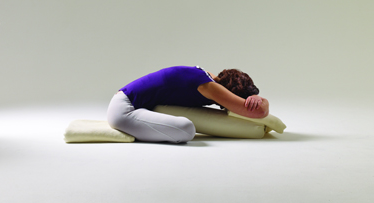
-
Sit with your legs crossed at the center of your shins in Svastikasana so that your feet rest underneath your knees. If your knees lift up higher than your pelvis, sit up on a blanket or two.
-
Pull a bolster onto your lap and place a folded blanket or two on the other end of the bolster. Press the end of the bolster down under your abdomen as you lengthen your torso forward.
-
Rest your abdomen and chest on the bolster, and your forehead on the blanket. Add more blankets, another bolster, or use a chair if you can’t comfortably reach the bolster.
-
Cross your forearms and hold your elbows, resting them overhead on top of the blanket.
-
Relax your forehead and eyes and allow your attention to withdraw as you rest for two minutes, before changing the cross of your legs and arms and repeating on the other side.
Sarvangasana (Shoulderstand Pose) with a Chair
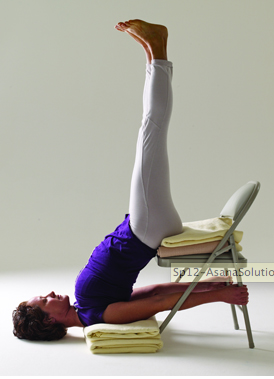
-
Place a chair about two feet away from a wall with the back of the chair to the wall. Put a folded mat with a folded blanket on top of it on the seat of the chair, and two or three folded blankets in front of the chair on the floor.
-
Sit backward on the chair with your legs bent over the top of the chair back. Scoot your hips as close to the backrest and wall as you can.
-
Holding the sides and then the front legs of the chair, lower your torso until your shoulders are on the blankets and your head is on the floor. Take your arms under the chair seat between the front legs of the chair to hold the back legs of the chair. Look toward your torso and relax your throat and tongue.
-
Place your feet on the top of the backrest of the chair. Roll the outer edges of your shoulders down and open your chest. Lift your shoulder blades and the sides of your rib cage up perpendicular to the floor.
-
Keep your hips on the seat of the chair as you stretch your legs up to the ceiling one at a time. Keep your legs perpendicular to the floor, straighten the knees, and balance the two sides of your pelvis evenly on the seat of the chair.
-
After a couple of minutes, you can take your legs, one at a time, up onto the wall. Rest the backs of your heels on the wall with your legs straight. If you can’t reach the wall, keep your legs straight up perpendicular to the floor or rest your feet on the top of the chair’s backrest with your knees bent.
-
Hold this asana for up to 10 minutes.
-
To come out of the pose, bend your knees and place your feet on top of the chair’s backrest. Let go of the chair legs with your hands and, pushing the chair toward the wall with your feet, slowly slide back off the chair until your pelvis reaches the floor.
-
Rest for a minute on your back with your calves on the seat of the chair and a blanket underneath your head (not your shoulders). Then roll to your right side and sit up.
Viparita Karani (Legs Up the Wall Pose)
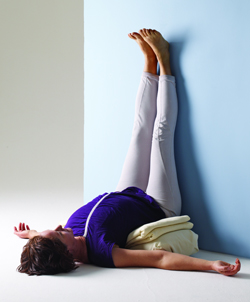
-
Place a bolster with two folded blankets on top of it near a wall, with a couple of tall blocks between the bolster and the wall to keep the bolster from rolling into the wall.
-
Sit with your right outer hip on the bolster so your sit bones are touching the wall. Use your hands behind you on the floor to support you as you roll your sacrum onto the bolster and your legs up the wall.
-
Push your hands into the floor to push your hips closer to the wall. Gently lower your head and shoulders to the floor, careful to keep your hips close to the wall.
-
As in Sarvangasana, roll the outer shoulders down into the floor and lift the sides of your chest. Relax your throat and allow the neck to lengthen away from the bolster. Relax the abdomen and allow it to recede back toward the bolster.
-
Close your eyes and settle here for 10 to 15 minutes. If your legs get tired, cross them in Svastikasana, feet resting on the wall for a few breaths, switching the cross halfway through.
-
To come out of the pose, bend your knees and bring your knees and feet together. Press the feet into the wall and slide off the bolster until your whole back is on the floor.
-
Cross your legs in Svastikasana and rest them on top of the bolster; switch the cross of your legs halfway through. Then roll over to rest on your right side before sitting up.
More insightful yoga practice tips and inspiration from Marla Apt: Refine Your Salabhasana-Building Stamina and Vigor in Locust Pose.
Reprinted with permission from Marla Apt and yoganga.com
Originally published in Yoga International Magazine
 Based in Los Angeles, Marla is a Senior level Certified Iyengar Yoga teacher. Her 25 years of experience have made her a prominent instructor both throughout the United States and abroad, where she leads workshops, intensives, retreats, and teacher training programs.
Based in Los Angeles, Marla is a Senior level Certified Iyengar Yoga teacher. Her 25 years of experience have made her a prominent instructor both throughout the United States and abroad, where she leads workshops, intensives, retreats, and teacher training programs.
Since visiting India for the first time to conduct research for a degree in Buddhist Philosophy, Marla has returned annually to pursue an education in yoga under the direction of B.K.S. Iyengar and his children, Geeta and Prashant.
In a piece by Yoga Journal Magazine, Marla was highlighted as one of twenty-one young yoga teachers helping to “shape the future of yoga.” She has assisted with medical research studies at UCLA regarding yoga as a treatment for depression, anxiety, and IBS. In addition, Marla has created the first yoga therapy content to be incorporated into the curriculum of the David Geffen School of Medicine at UCLA.
Featured Courses









